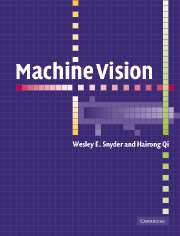Book contents
- Frontmatter
- Contents
- To the instructor
- Acknowledgements
- 1 Introduction
- 2 Review of mathematical principles
- 3 Writing programs to process images
- 4 Images: Formation and representation
- 5 Linear operators and kernels
- 6 Image relaxation: Restoration and feature extraction
- 7 Mathematical morphology
- 8 Segmentation
- 9 Shape
- 10 Consistent labeling
- 11 Parametric transforms
- 12 Graphs and graph-theoretic concepts
- 13 Image matching
- 14 Statistical pattern recognition
- 15 Clustering
- 16 Syntactic pattern recognition
- 17 Applications
- 18 Automatic target recognition
- Author index
- Index
6 - Image relaxation: Restoration and feature extraction
Published online by Cambridge University Press: 05 June 2012
- Frontmatter
- Contents
- To the instructor
- Acknowledgements
- 1 Introduction
- 2 Review of mathematical principles
- 3 Writing programs to process images
- 4 Images: Formation and representation
- 5 Linear operators and kernels
- 6 Image relaxation: Restoration and feature extraction
- 7 Mathematical morphology
- 8 Segmentation
- 9 Shape
- 10 Consistent labeling
- 11 Parametric transforms
- 12 Graphs and graph-theoretic concepts
- 13 Image matching
- 14 Statistical pattern recognition
- 15 Clustering
- 16 Syntactic pattern recognition
- 17 Applications
- 18 Automatic target recognition
- Author index
- Index
Summary
To change, and to change for the better are two different things
German proverbIn this chapter, we move toward developing techniques which remove noise and degradations so that features can be derived more cleanly for segmentation. The techniques of a posteriori image restoration and iterative image feature extraction are described and compared. While image restoration methods remove degradations from an image [6.3], image feature extraction methods extract features such as edges from noisy images. Both are shown to perform the same basic operation: image relaxation. In the advanced topics section, image feature extraction methods, known as graduated nonconvexity (GNC) and variable conductance diffusion (VCD), are compared with a restoration/feature extraction method known as mean field annealing (MFA). This equivalence shows the relationship between energy minimization methods and spatial analysis methods and between their respective parameters of temperature and scale. The chapter concludes by discussing the general philosophy of extracting features from images.
Relaxation
The term “relaxation” was originally used to describe a collection of iterative numerical techniques for solving simultaneous nonlinear equations (see [6.18] for a review). The term was extended to a set of iterative classification methods by Rosenfeld and Kak [6.64] because of their similarity. Here, we provide a general definition of the term which will encompass these methods as well as those more recent techniques which are the emphasis of this discussion.
- Type
- Chapter
- Information
- Machine Vision , pp. 107 - 143Publisher: Cambridge University PressPrint publication year: 2004



